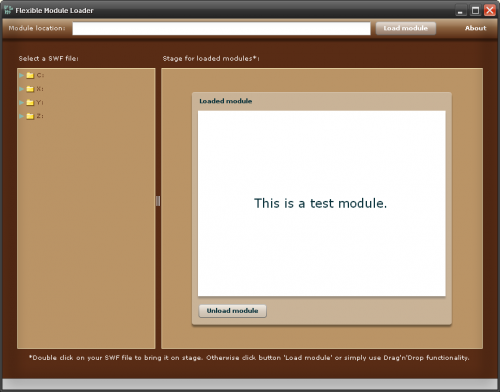 Christof Müller
24. Jun, 2009
Christof Müller
24. Jun, 2009
The more complex your amf-speaking Flex app, the more painful and time consuming the act of testing and debugging your Rails controllers gets. Even if testing a specific controller method via the Flex gui only takes you a couple of clicks, it adds up. Plus, if you want to investigate how your controller reacts to unexpected, even invalid parameters, you’ll end up spending your day editing Flex code, recompiling, launching and clicking around in your Flex app – although you actually want to test your controllers. That’s bad. The issue gets even more severe if you consider the fact that Rails’ integrated functional testing environment doesn’t work with pure amf (see this thread for a very tentative try to get it working). Weiterlesen »
Schlagworte: amf •
Flex •
Rails
 Simon Biemer
7. Mai, 2009
Simon Biemer
7. Mai, 2009
 A common way to load code during run time in a Flex 3 (Air) application is using Modules. This special type of dynamically loaded SWF files allows the application to load separate parts that it requires only when it needs them. The user experiences shorter loading times due to smaller SWF file size and the developer can separate features into single modules that he can work on independently.
A common way to load code during run time in a Flex 3 (Air) application is using Modules. This special type of dynamically loaded SWF files allows the application to load separate parts that it requires only when it needs them. The user experiences shorter loading times due to smaller SWF file size and the developer can separate features into single modules that he can work on independently.
So far so good but unfortunately they cannot be run in a stand-alone way. Instead they must be loaded in an application. This makes it rather complicated when it comes to testing. If you have an extensive application with lots of different functionalities which are encapsulated into many different modules it can be very annoying to deploy the whole application just for testing only a small aspect. At this point the ‘Flexible Module Loader’ (FML) is going to be a very helpful tool.
Weiterlesen »
Schlagworte: Actionscript •
Air •
Flex
 Johannes Koch
25. Nov, 2008
Johannes Koch
25. Nov, 2008
You probably know two or three different ways to create Adobe Flash UIs. The most straightforward and expensive one is using Adobe’s Flex Builder. This IDE offers a quick, flexible and reliable way to program a UI in MXML – Adobe’s XML-based UI description language – and ActionScript – the corresponding scripting language to give life to the MXML UI components. For students, Lehman stock owners and other less pecunious people, there is the Flex 3 SDK and a bunch of tutorials on the web on how to teach Eclipse MXML and ActionScript. But did you ever think about using Java to write a Flash UI? You could integrate a fancy Flash UI with your Java application more smoothly, or you could write a Flex code generator in Java (maybe even provide other developers with a DSL that your Java-based generator can translate into Flex applications?). Using only free software, it doesn’t take more than a couple of minutes to create such a Java library for Flex Applications – this tutorial shows you how to do it.
Weiterlesen »
Schlagworte: Code Generation •
Flex •
Java •
JAXB •
MXML •
XJC •
XML Schema
 Mario Neugebauer
1. Sep, 2008
Mario Neugebauer
1. Sep, 2008
In Produktionsumgebungen stehen Geräte meist nicht nur so für sich und die Datenakquise alleine in der Fabrikhalle. Auch der eine oder andere Maschinenbediener oder Werker will mal mit den Prozessen über einen Touchscreen interagieren. Und wenn er dann die Handschuhe nicht ausziehen kann, hat er ein Problem. Die für den Mauszeiger gedachten Scrollbalken verbieten jegliche Bedienung per Handschuh. Zum Glück kann man Bedienoberflächen auf Bildschirmen auch in grafischer Hinsicht speziell für solche Eingabegeräte anpassen – beispielsweise mit Flex.
Weiterlesen »
Schlagworte: Automatisierung •
Flex •
HMI •
touchscreen •
usability
 Christof Müller
Christof Müller  Simon Biemer
Simon Biemer 
 Johannes Koch
Johannes Koch  Mario Neugebauer
Mario Neugebauer 